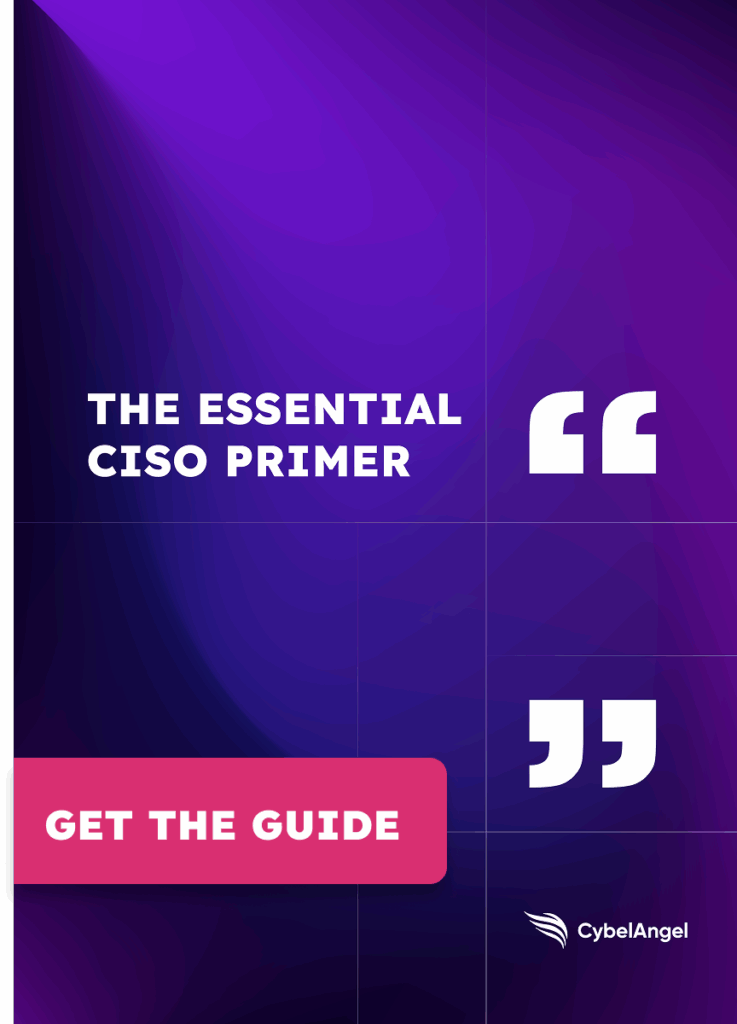The Ultimate Guide to Financial Services Cybersecurity [Part 1]
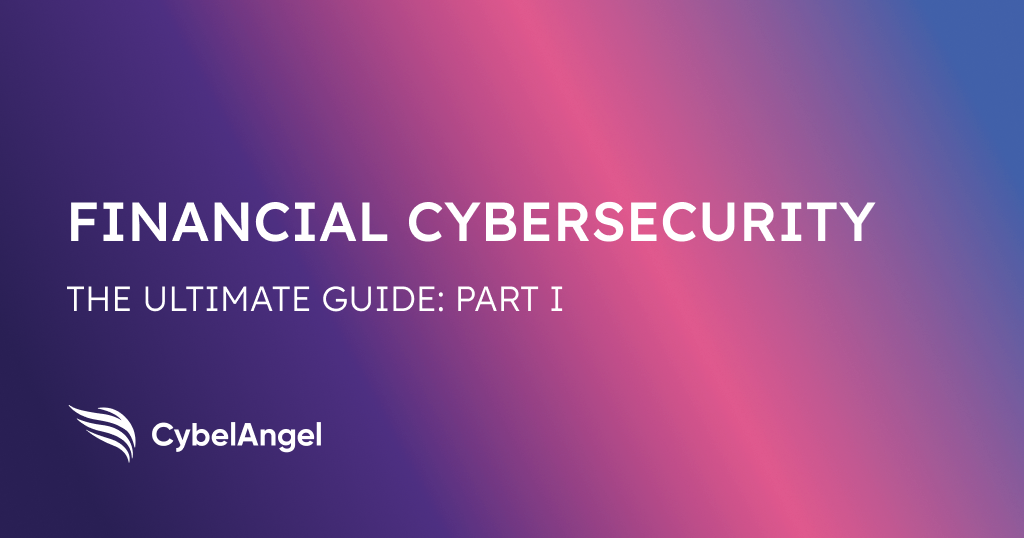
Table of contents
The financial services industry is 300 times more likely than any other institution to experience cybercrime.
Profit is the main motivator for threat actors. And with vulnerabilities such as huge amounts of sensitive information, high-volume transactions, and extreme regulatory compliance pressures, there are countless security risks in the finance world for cybercriminals to exploit.
This is why protecting the financial services sector from the outside is vital. Let’s explore why protecting the external attack surface could make all the difference for financial services companies.
1. What is cybersecurity in financial services?
Cybersecurity in financial services is all about safeguarding digital assets, from banking platforms to financial data and beyond.
A strong cybersecurity framework is essential for maintaining customer trust, protecting service providers’ reputations, and ensuring the stability of critical infrastructure.
When it comes to finance and cybersecurity, both internal and external protections must be in place. In particular, cybersecurity solutions focus on:
- Information security: Preventing a data breach and keeping digital assets safe
- Threat intelligence: Proactively monitoring cybersecurity threats to stay ahead of hackers
- External attack surface management (EASM): Building cyber resilience in public-facing assets and financial systems (more on this later)
Having robust cybersecurity measures is imperative, especially since the finance industry has suffered $12 billion in losses from cyber attacks over the past 20 years.

Source: An IMF graph showing financial sector cyber incidents and losses since 2004.
2. Why are financial services a target for cyber attacks?
Financial reward is the main motivator for cybercriminal gangs, and this can manifest itself in a variety of cyber threats, including:
- Financial gain: It goes without saying, but banks, credit unions, and other financial services organizations process huge sums. Cybercriminals can easily take advantage of this. For example, they might try to bypass access controls, ransom valuable data, or set up fraudulent transactions.
- Sensitive data theft: “Knowledge is power”, and this couldn’t be more true when it comes to cyber security threats to the financial sector. Attackers can use institutional and customer data for their own benefit. For instance, they could sell the sensitive data to other threat actors, use it to commit identity theft or force the organization to pay a ransom to get the data back.
- Reputational damage: Some cybercriminals also want to disrupt economies or damage reputations. For example, a national bank cyber attack would create instability and affect public confidence in the financial institution.
- Market manipulation: 25% of finance leaders found that their market data was the main target for cyberattacks. This form of ‘economic espionage’ could allow criminal groups to get ahead of the markets and manipulate stock and share prices.
These motives could appeal to any number of threat actors, from hackers, to nation-states, and even to insider threats from disgruntled employees, for example. The International Money Fund (IMF) features a breakdown of these groups, and what their goals and methods can be.
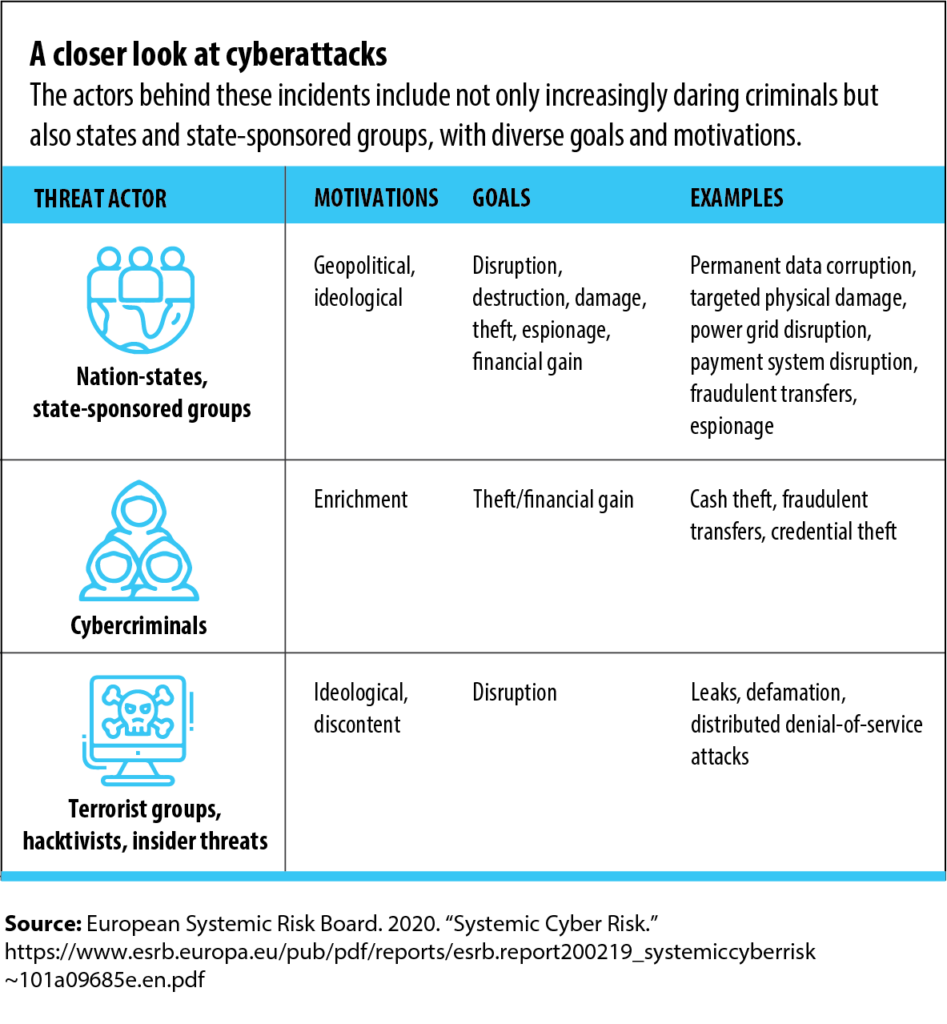
Along with their different objectives, each threat actor also has their own unique set of tactics. Let’s explore some of the most common types of cyber incidents…
3. What is the most common cyber attack in the financial sector?
There are lots of cyber risks associated with the finance industry, and you just have to Google “financial cyber attacks news” to see that there are fresh cyber incidents all the time.
Here are the main types of cyber attacks, with some scenarios as examples.
Phishing
- Definition: Phishing is a social engineering technique that uses deceptive messages, emails, and sites to gain someone’s trust.
- Scenario: An employee receives an email from the “CEO”, asking them to click a link to open an important document, which actually downloads a piece of malware to gain unauthorized access.
Ransomware attacks
- Definition: Ransomware attacks are when valuable data is stolen and encrypted until the target pays a ransom to retrieve it.
- Scenario: A regional bank has all of its user data encrypted, and is asked by cybercriminals to pay $52 million to get it back, severely damaging customer trust.
DDoS attacks
- Definition: A Distributed Denial-of-Service (DDoS) attack is when hackers flood a system with traffic to overwhelm it and stop usual operations.
- Scenario: Users can no longer log in to a large financial services firm after its servers are suddenly overwhelmed by abnormal levels of internet traffic.
Insider threats
- Definition: Someone from within the financial institution will compromise online systems, either intentionally or unintentionally. Human error is the primary cause of cybersecurity breaches, after all.
- Scenario: A disgruntled bank employee leaks sensitive customer data onto a public social media platform, causing a regional scandal and forcing the bank to share a press release.
Supply chain attacks
- Definition: A supply chain attack is when hackers target a vulnerability in a third-party vendor or service, which could compromise the wider organization’s system.
- Scenario: Hackers bypass a bank’s email marketing provider and access their customers’ email addresses.
Artificial intelligence attacks
- Definition: An artificial intelligence cyber attack is when hackers use AI and machine learning to speed up or enhance a cyber incident.
- Scenario: Cybercriminals create a fake AI chatbot, using deepfake technology and human-like interactions to trick a bank employee into sharing sensitive customer data.
4. What are the consequences of cyber incidents in the financial sector?
The most obvious consequence of cybercrime is financial loss, which can easily climb into the millions. This is because the cost implications include identifying the cybercrime, recovering any lost data or systems, informing customers and stakeholders, and improving security standards. It can also lead to failed business opportunities, affecting revenue in the long run.
A 2024 IBM report found that the finance industry has the second-highest data breach costs, surpassed only by healthcare.
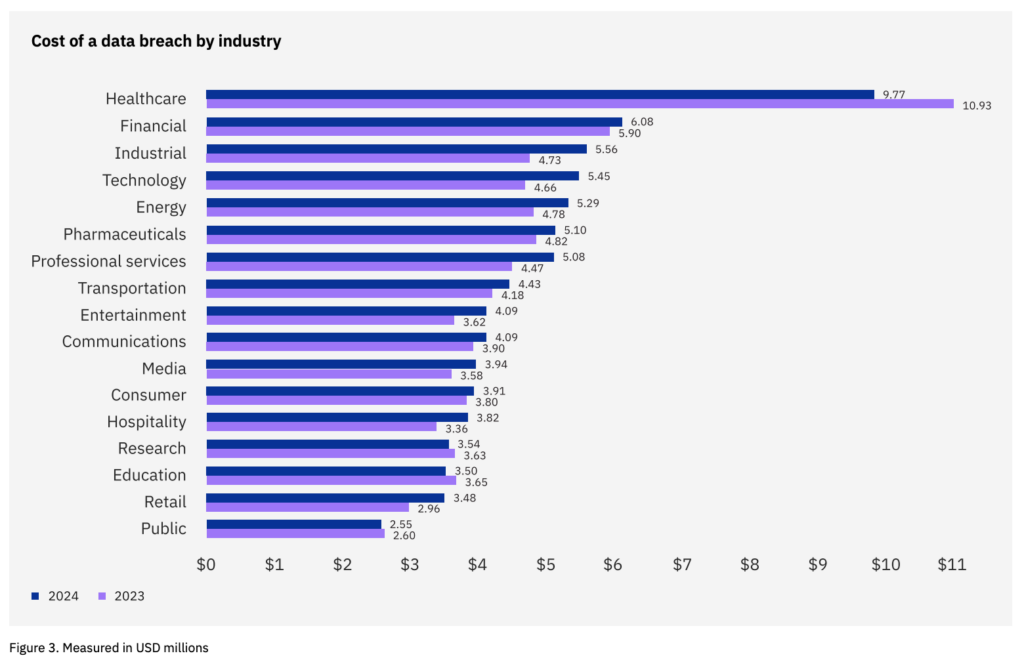
Another danger is the interconnectivity of our banking systems. In a cybersecurity risk report, the Federal Reserve Bank of New York highlighted the dangers of a “spillover” or “cascade” effect. It modeled how a cyber incident could affect the US financial system, and concluded that an attack on any of the top five U.S. banks could disrupt nearly 38% of the national financial network.
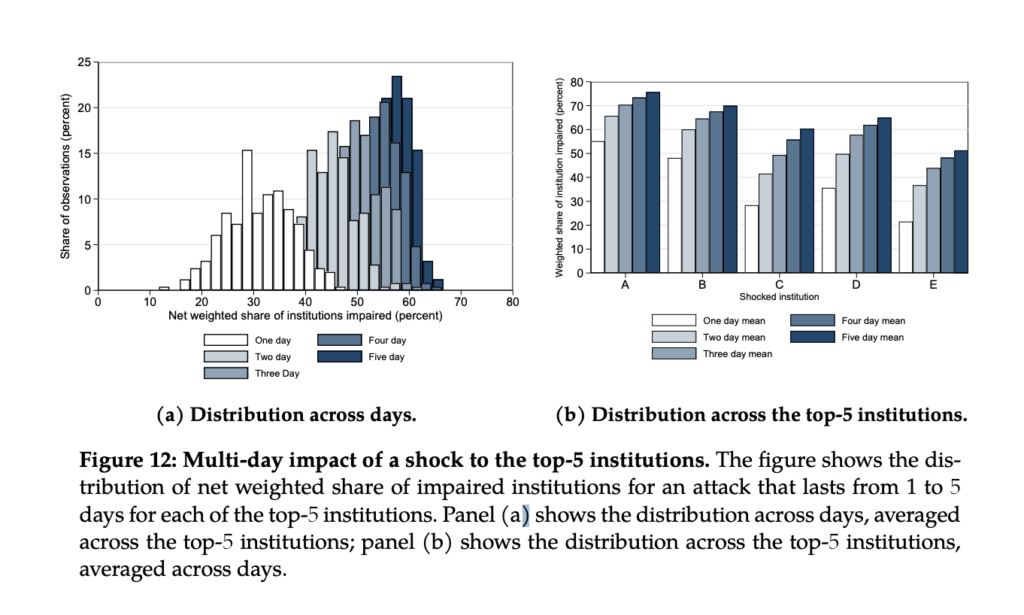
Cyber incidents can also cause significant downtime. From halting online banking platforms to freezing trading systems, these disruptions can lead to millions in lost revenue and create serious inconvenience for customers.
Unfortunately, this also means that institutions can lose customer trust and suffer reputational damage which could take years to repair. Trust is a cornerstone of the financial industry. A single breach can erode public confidence and cause customers to move their assets to competitors.
Finally, financial institutions also suffer severe regulatory penalties in the event of a data breach, for example. And for a global attack, navigating the regulatory requirements of multiple jurisdictions can add further complications.
5. What types of cyber terrorism must your financial services firm be aware of?
Unlike typical cybercriminals looking for quick cash, cyber terrorists aim to disrupt. They may target financial institutions to harm national economies, cause public panic, or make political statements.
Cyber terrorism comes in many forms, but here are two major threats financial services firms need to watch closely:
- State-sponsored attacks: Some countries use cyber attacks to undermine financial stability in rival nations. These state-sponsored attacks can be highly sophisticated. For example, in 2016, the Central Bank of Bangladesh was hit by a state-sponsored cyber heist (allegedly caused by North Korea), leading to a loss of $81 million.
- Hacktivism: Hacktivists often target large financial firms to draw attention to issues like environmental policy, social issues, or economic inequality. Their goal may be to leak sensitive data or deface websites, rather than directly profiting from the attack. For instance, in 2010, the hacktivist group Anonymous launched attacks on several financial institutions, including Visa and Mastercard.
6. Why is external attack surface protection so essential?
In cybersecurity, the “external attack surface” refers to everything a financial institution has online that is visible to the outside world.
This includes:
- Public-facing websites
- Mobile apps
- Customer portals
- APIs
- Cloud servers
These are the systems that anyone with an internet connection can potentially access, and they’re where attackers often focus their efforts. Why? Because if just one of these systems has a vulnerability, it can open a door into the organization’s network.
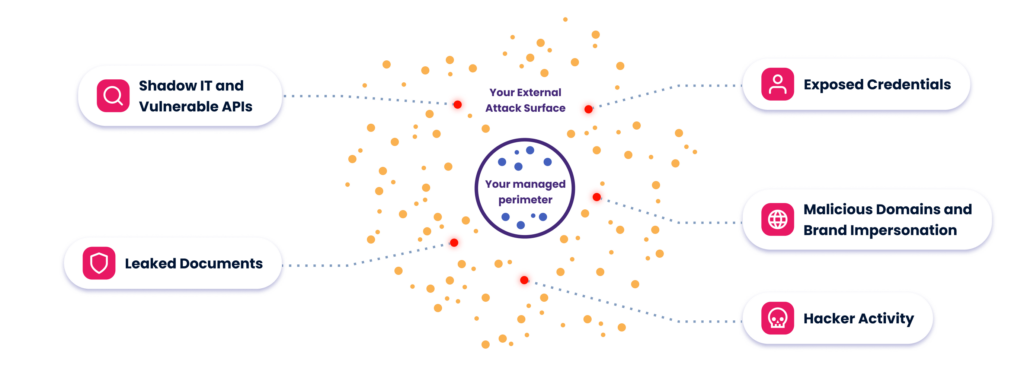
The challenge of EASM in the financial sector
The challenge with protecting the finance industry’s external attack surface is that it’s constantly expanding. This is especially the case since the COVID-19 pandemic, when financial organizations all went through a digital transformation to navigate remote policies. Every time a new tool, application, or server is added, the financial services industry’s attack surface grows.
Over time, some of these assets—especially older systems or shadow IT (unapproved, unmanaged software)—can go unmonitored. When these “forgotten” assets are left unsecured, they can become easy targets for attackers.
Finding an EASM provider for financial systems
External attack surface management is all about identifying, monitoring, and securing a financial system’s assets. To do that, financial organizations need to use the right EASM tool.
CybelAngel is an EASM tool that specializes in securing digital activities against cyber attacks and data breaches.
It works via:
- Asset discovery and monitoring: Identifying vulnerable digital assets—before the hackers do.
- Data breach prevention: Spotting any data leaks before they become a problem.
- Account takeover prevention: Stopping stolen credentials from being sold on the dark web.
- Dark web monitoring: Tracking cybercriminal activities to sidestep an attack.
- Domain protection: Taking down fraudulent sites before they damage brand reputation or affect customers.
To discover how CybelAngel can support cybersecurity in financial sector organizations, book a demo and see it in action.
7. What is the role of the CFO in cybersecurity?
Unfortunately, financial organizations can’t just leave cybersecurity with the IT team. It’s a crucial part of a company’s overall strategy, and the Chief Financial Officer (CFO) plays a key role.
The CFO must find a balance between investing in cybersecurity and managing the company’s broader financial goals. This can be a delicate task, as cybersecurity can be costly, but the risks of underfunding it are even greater.
In particular, the CFO should:
- Guide risk management: Recognizing financial cybersecurity threats and ensuring resources and tools such as CybelAngel are available to address them
- Oversee compliance: Ensuring that the organization follows all financial and data protection regulations
- Ensure collaboration: Working closely with Chief Information Security Officers (CISOs) to decide where to focus cybersecurity efforts
8. How should financial services approach their cybersecurity strategy?
While larger financial organizations have improved their security posture, the number of small and medium businesses (SMEs) with the minimum viable cyber resilience level has dropped by 30%.
And as we saw with the interconnectivity of financial systems, this puts the whole industry at risk.
So what can financial organizations do?
The US-based Cybersecurity and Infrastructure Security Agency (CISA) recommends these four security measures for the financial sector.
- Prioritize information sharing: Whether it’s a new vulnerability or an emerging cybersecurity trend, sharing information between organizations, third parties, and governing bodies is key. And the communication should be both “timely and actionable.”
- Follow best practices: All finance corporations should level up their risk management plans and adhere to the NIST Cybersecurity Framework. They should also secure their third-party operations, too.
- Set up incident response and recovery plans: Banks and financial institutions should collaborate with governing bodies and law enforcement to recover from any cyber incidents, using coordinated response plans.
- Stick to (and enhance) policy frameworks: All financial organizations should promote adherence to current regulatory frameworks, and support efforts to improve cybersecurity policy over time.
Conclusion
Protecting the external attack surface is crucial for financial institutions facing growing cyber threats. By understanding these risks and fostering strong collaboration across teams, especially between CFOs and CISOs, financial organizations can build resilient defenses.
Book a demo call with CybelAngel to learn how to secure your external attack surface in real-time, and be sure to check out the blog for more cyber security articles.

